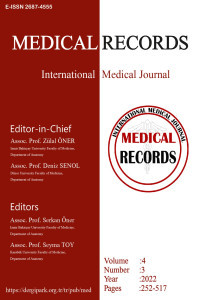Çocuklarda Zor Entübasyon ile İlişkili Olabilecek Antropometrik Ölçümlerin Belirlenmesi
Zor entübasyon, baş/boyun oranı, vücut kitle indeksi, Cormack-Lehane skoru, Mallampati skoru
Determination of Anthropometric Measurements that may be Associated with Difficult Intubation in Children
Difficult intubation, head/neck ratio, body mass index, Cormack-Lehane score, Mallampati score,
___
- Utting JE. Pitfalls in anesthetic practice. Br J Anaesth 1987;59:877-90.
- Valois-Gómez T, Oofuvong M, Auer G, et al. Incidence of difficult bag-mask ventilation in children: a prospective observational study. Paediatr Anaesth. 2013;23:920-6.
- Gupta S, Sharma R, Jain D. Airway assessment: predictors of a difficult airway. Indian J Anaesth. 2005;49:257-62.
- Gregory GA, Riazi J. Classification and assessment of the difficult pediatric airway. Anesthesiol Clin North America. 1998;16:729-41.
- Shahhosseini S, Montasery M, Saadati M, et al. Comparative Evaluation of Difficult Intubation Predictors in Children Under Two Years of Ages. Anesth Pain Med. 2021;11: e118931.
- Mallampati SR. Clinical sign to predict difficult tracheal intubation (hypothesis). Can Anaesth Soc J. 1983;30:316-7.
- Mallampati SR, Gatt SP, Gugino LD, et al. A clinical sign to predict difficult tracheal intubation: a prospective study. Can Anaesth Soc J. 1985;32:429-34.
- Samsoon GL, Young JR. Difficult tracheal intubation: a retrospective study. Anesthesia. 1987;42:487-90.
- Lee A, Fan LTY, Gin T et al. A systematic review (meta-analysis) of the accuracy of the Mallampati tests to predict the difficult airway. Anesth Analg. 2006;102:1867-78.
- Huh J, Shin HY, Kim SH, et al. Diagnostic predictor of difficult laryngoscopy: the hyomental distance ratio. Anesth Analg. 2009;108: 544-8.
- Khan ZH, Mohammadi M, Rasouli MR, et al. The diagnostic value of the upper lip bite test combined with sternomental distance, thyro-mental distance, and inter incisor distance for prediction of easy laryngoscopy and intubation: a prospective study. Anesth Analg. 2009;109:822–4.
- Merah NA, Wong DT, Ffoulkes-Crabbe DJ, et al. Modified Mallampati test, thyromental distance, and inter-incisor gap are the best predictors of difficult laryngoscopy in West Africans. Can J Anaesth. 2005;52:291-6.
- Shirgoska B, Netkovski J. Predicting difficult airway in apparently normal adult and pediatric patients. Prilozi. 2013;34:155-9.
- Mansano AM, Módolo NSP, Silva LM, et al. Bedside tests to predict laryngoscopic difficulty in pediatric patients. Int J Pediatr Otorhinolaryngol. 2016;83:63-8.
- Eberhart LHJ, Arndt C, Cierpka T, et al. The reliability and validity of the upper lip bite test compared with the Mallampati classification to predict difficult laryngoscopy: an external prospective evaluation. Anest Analg. 2005;101:284-9.
- Santos AP, Mathias LA, Gozzani JL, et al. Difficult intubation in children: applicability of the Mallampati index. Revista Brasileira de Anestesiologia, 2011;61:159-62.
- Kim WH, Ahn HJ, Lee CJ, et al. Neck circumference to thyromental distance ratio: a new predictor of difficult intubation in obese patients. Br J Anaesth 2011;106:743-8.
- Liu Y, Wang J, Zhong S. Correlation between clinical risk factors and tracheal intubation difficulty in infants with Pierre-Robin syndrome: a retrospective study. BMC Anesthesiol. 2020;20:1-6.
- Yayın Aralığı: Yılda 3 Sayı
- Başlangıç: 2019
- Yayıncı: Zülal ÖNER
Dördüncü ve Beşinci Parmak Metakarpofalangeal Eklemde Kalsiyum Depolanması
Serhat EKREM, Harun KÖSE, Zeynep MARAŞ ÖZDEMİR, Kadir ERTEM
0-6 Yaş Arası Çocukların Ev Kazalarının Sıklığı ve Anne Güvenlik Önlemlerinin Tanı Düzeyleri
Dilek ENER, Mehmet Yavuz ÖZBEY
Balık Yağı Takviyeleri Kullanımı Benign Pediyatrik Epistaksisi Uzatır Mı?: Bir Olgu
Asıya Bağlı Uzun Styloid Proçes Kırığı
Turgay BÖRK, Muhammet BATBAŞ, Nazif Harun VİCDANLI, Abdürrahim TÜRKOĞLU
Gastrik Intestinal Metaplazi Sıklığı ve Helikobakter Pilori ile İlişkisinin Belirlenmesi
Serdar DURAK, Arif Mansur COŞAR, Sami FİDAN
Fibromyaljisi Olan Diabetes Mellitus Hastaları Yüksek Kardiovasküler Hastalık Riskine Sahipler
Pediatrik Ewing Sarkoma Hastalarının Multimodal Tedavisinde Adjuvan Radyoterapi
Gonca ALTINIŞIK İNAN, İpek Pınar ARAL, Tarık KARGIOĞLU, Arzu YAZAL ERDEM, Selma ÇAKMAKCI, Hüseyin Furkan ÖZTÜRK, Suheyla AYTAÇ ARSLAN, Yılmaz TEZCAN
